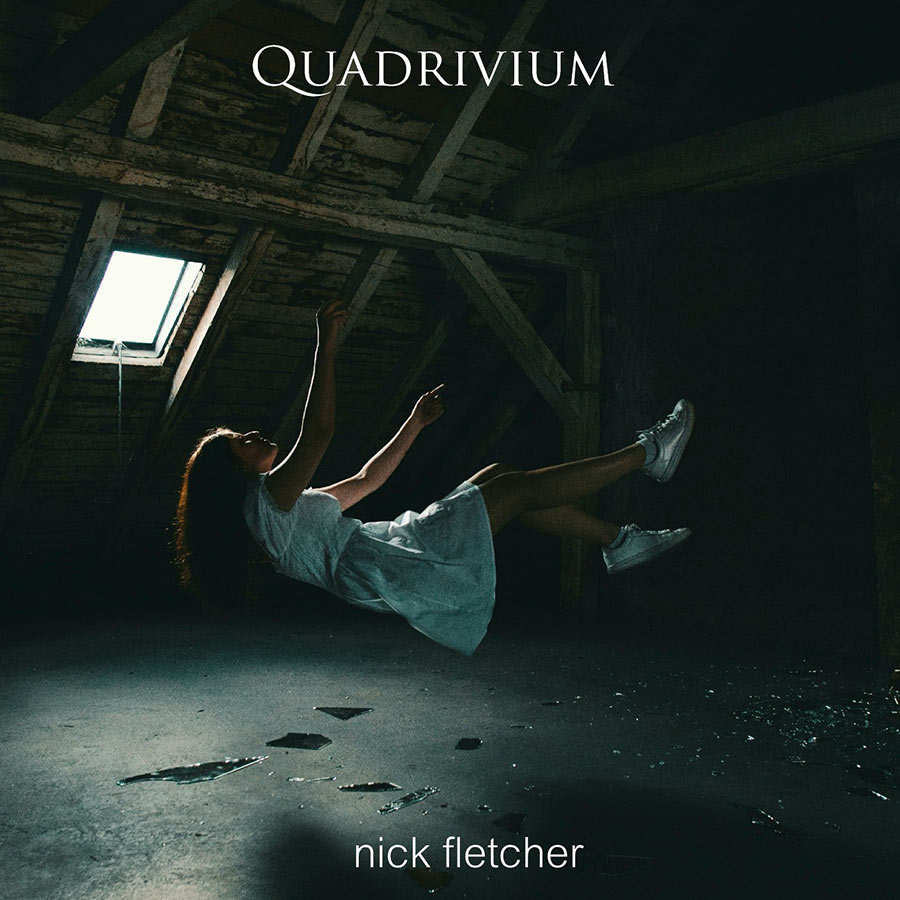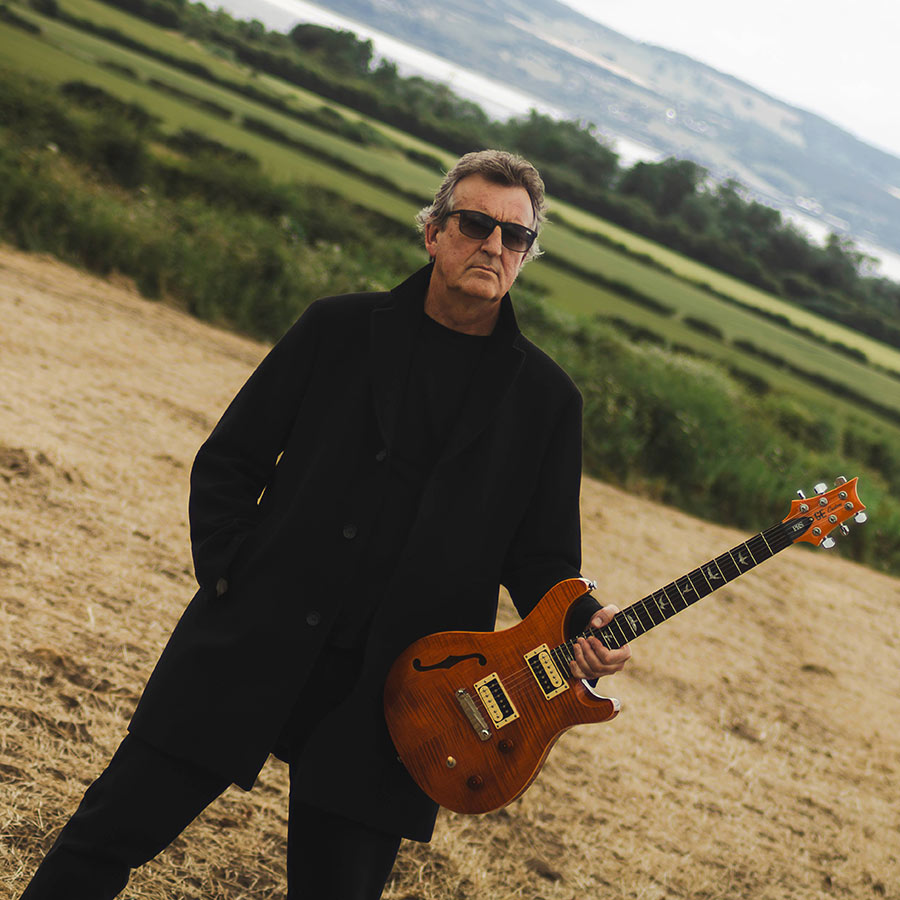- Artikel
- Lesezeit ca. 7 Minuten
Nick Fletcher – Quadrivium – album review
Two years after the highly acclaimed solo album Cycles Of Behaviour and one year after its follow-up The Cloud Of Unknowing, Nick Fletcher (John Hackett Band) presents a follow-up with Quadrivium. Thomas Jesse has listened to it.

Preface
Nick Fletcher has now released his third work of jazz-rock-prog-fusion music within three years. What more do we need to say about this likeable, intelligent and creative Brit? Steve Hackett has already called him the best contemporary jazz guitarist in the UK. *1 And let us not forget his classical side. Again and again he plays acoustic concerts and releases albums of classical guitar music.
Genesis fans will notice him mainly for collaborations with John Hackett as an acoustic duo, or as a member of the John Hackett Band. *2
Background info / album title
In philosophy, beginning with Plato (Politeia, Nomoi), the “quadrivium” comprises the four higher of the seven “liberal arts” of arithmetic, geometry, astronomy and music (the “trivium” consists of grammar, rhetoric and dialectic). These four were given special attention in university teaching in the Middle Ages.
The tracks on the album are dedicated to each of these arts. Just as these four arts ultimately form a unity, the pieces of music should be listened to in context and as a whole. They come together to form a kind of suite that takes the listener on a journey into the interior of the soul (Inner Space) as well as into the universe (Outer Space). These also form a unity.
Artwork and design
 The CD comes in a jewel case. The cover opens up a view of a gloomy attic. A faint glimmer of light illuminates the scene through a single skylight. Shards of a broken mirror lie scattered on the floor. The viewer is drawn to the young woman floating in mid-air in the center. She spreads her arms – is she welcoming someone, does she float away with rowing movements, or is she just dreaming? The booklet contains photos of Nick and drummer Anika Nilles as well as gloomy pictures of women floating in mid-air in car parks or a landscape in the light of the sunset and a person standing in a dark room in front of a huge gate flooded with light. Liner notes etc. are included. Photos and layout were done by Nick Fletcher in collaboration with Rick Pilkington. The artwork congenially points to the content of the instrumental music: dreams, transitions into other worlds, death, the meaning of life.
The CD comes in a jewel case. The cover opens up a view of a gloomy attic. A faint glimmer of light illuminates the scene through a single skylight. Shards of a broken mirror lie scattered on the floor. The viewer is drawn to the young woman floating in mid-air in the center. She spreads her arms – is she welcoming someone, does she float away with rowing movements, or is she just dreaming? The booklet contains photos of Nick and drummer Anika Nilles as well as gloomy pictures of women floating in mid-air in car parks or a landscape in the light of the sunset and a person standing in a dark room in front of a huge gate flooded with light. Liner notes etc. are included. Photos and layout were done by Nick Fletcher in collaboration with Rick Pilkington. The artwork congenially points to the content of the instrumental music: dreams, transitions into other worlds, death, the meaning of life.
Musicians involved
The album’s contributors are (as always) co-producer and mixer Caroline Bonnett(keyboards), Dave Bainbridge (known from Iona, Strawbs, keyboards on 3,5 & 6) and Tim Harries (bass, known for Iona, Steeleye Span, Bruford’s Earthworks). Special attention is paid to the drummer of the album, Anika Nilles (Jeff Beck). There are photos of her in the booklet and the album is also promoted using her name.
Songs
A Wave On the Ocean of Eternity (Prelude)4:16
Floating keyboard carpets reminiscent of Iona, the late Pink Floyd or ambient music, draw the listener into the soundscape of the album. A Floydy guitar crowns the quiet piece. Yes, it is a-floating in soothing, flowing sounds. Memories of the preludes (Wagner uses this term) of classical operas are awakened. Isn’t this beautiful progressive rock music?
Overture to the Cosmos (Overture) 4:53
An overture follows, which begins with a guitar thunderstorm. As in the new works of Steve Hackett, the rocking starts. Here, Anika Nilles draws attention for the first time with her straightforward, driving drumming. In the last third, Nick’s guitar begins to float, breaking out towards the cosmos. The end picks up the dreamy sound of Prélude again.
Riding the Event Horizon (Scene 1) 6:17
Now it gets jazzy. Alan Holdsworth looks in. Again, spot the fine drumming. Of course, we also hear a little bit of the Jeff Beck sound. In the middle of the piece a jazzy piano solo shines followed by a guitar. Wonderful rhythms, twists, solos fill the brilliant ride on the edge of the universe. A humorous highlight of the album. A tongue-in-cheek allusion to the science fiction film Event Horizon, or the flight with the spaceship of the same name?
Ziggurat of Dreams (Part 1) (Interlude) 2:41
What awaits us in the celestial hill of dreams? Versatility, changeability? Nick calls the piece an interlude. It is a dreamlike, jazzy, playful guitar solo, accompanied by gentle keyboard sounds. Nick proves to us that he doesn’t have to hide behind the grandees of jazz guitar. Wonderful!
The Fifth Parallel (Scene 2) 6:42
Quiet guitar arpeggios rise and develop into a beautiful melody. The drums start out cautiously. The bass merely hums its notes. Why does Bruford’s Earthworkscome to mind here? Is it the fantastic rhythm section? From minute two on, the reins are tightened and the rocking starts. A wonderful bass solo breaks the sound storm. Tim Harries shows his skills, only to be replaced by Nick’s guitar, which reverts to the melody, which in turn is picked up by a soloing keyboard. Is this Dave Bainbridge discovering the jazzman in him? By the end, everyone finds themselves in the melody. Slowly, with dabs of guitar, another jewel of the album ends.
 Aphelion (Scene 3) 7:25
Aphelion (Scene 3) 7:25
In astronomy, aphelion is the point at which a planet is at its greatest distance from the sun. But the music is not that far removed from the life-giving powers of the sun. The rough, raw guitar playing sounds quite grounded, interrupted by pearly piano cascades. The drums swirl, drive and even have a little solo at minute 4:30. The Mahavishu Orchestra or Brand X send their regards in this beautifully grooving jazz rock piece. Where does Nick get these incredible melodies? They enchant us, leave us happy.
Ziggurat of Dreams (Part 2) (Interlude)1:51
Ambient sounds, produced by keyboards and guitar, soothe the listener.
The Helix (Scene 4)6:24
A piece whose mood is slightly reminiscent of “Mental Meditation” by UK. The helix unfolds in a very restrained way to slowly wind its way into the ear. It magically enchants the listener. The drums evoke the sophisticated sound of Bill Bruford. As if spellbound, listeners bow before the music.
To the Stars we shall Return (Interlude)2:56
Another moment of calm awaits us. Ambient sounds, tabla sounds, percussive rhythms accompany a guitar that increases more and more into an intricate solo. Are we travelling to the stars above India? An allusion to Hindu mysticism? The song is indeed the prelude to a journey to the Far East.
The Journey to Varanasi (Scene 5) 7:11
Heavy, metallic guitars play, keyboards sound in Far Eastern garb and sounds resembling a sitar develop into an Indian melody. On the journey to the spiritual centre of India, things really rock. Led Zeppelin meets jazz rock – what a combination! Well, the Zep made it to Kashmir. But in the middle of the song, the bass interrupts the journey. It pumps and bubbles until the metal sounds pick it up. The guitar begins to sing, the keyboard sounds chopped up – chaos reigns until everything is united under the sitar melody. This is stunning music that reveals a raw beauty in its emotion, its wildness. The third highlight!
Standing on the Edge of Time (Denouement)4:14
At the edge of time, the circle closes. The denouement takes up the music of the prelude. Nick delights the listener with a floating, Floydian guitar. It jubilates over the end, which is again the beginning. Life dissolves, to the stars we go, to be reborn as stardust.
All in all
 Nick Fletcher has succeeded once more in creating an intelligent album full of inspirational power and creativity. One could accuse him of having composedhis own music. But this is contradicted by the joy of playing, the freedom for the soloists and the warmth of the music. He embeds quotations from bands / musicians like U.K., Bruford, Mahavishnu Orchestra, Iona, also the Flower Kings into his own style of jazz, rock, prog. With the theme of the album he finds comforting words about the inevitable end of our existence on earth. It only ends so that we can go to the stars as dust. We are reborn in their light and float dreaming in the universe. Nick takes elements of ancient and medieval philosophy, alchemy and Far Eastern teachings and weaves them into a source of wonderful music by means of his artistic talent.
Nick Fletcher has succeeded once more in creating an intelligent album full of inspirational power and creativity. One could accuse him of having composedhis own music. But this is contradicted by the joy of playing, the freedom for the soloists and the warmth of the music. He embeds quotations from bands / musicians like U.K., Bruford, Mahavishnu Orchestra, Iona, also the Flower Kings into his own style of jazz, rock, prog. With the theme of the album he finds comforting words about the inevitable end of our existence on earth. It only ends so that we can go to the stars as dust. We are reborn in their light and float dreaming in the universe. Nick takes elements of ancient and medieval philosophy, alchemy and Far Eastern teachings and weaves them into a source of wonderful music by means of his artistic talent.
The album trailer shows Nick as his gaze sweeps the expanse of the sea.*3 Yes, his music is like the sea: on the one hand purring, softly rushing, on the other thundering and roaring, but always full of fascinating depths.
If you read his three jazz rock albums as a trilogy, this suite is the climax and the completion. What might follow it?
Post script
In the liner notes, Nick quotes a poem by Samantha Turner *4. The verses express with poetic power the core theme of the album, perhaps even of his entire oeuvre. I would like to include them here:
Daydream
Find joy in every moment
See the blue behind the grey
Don’t be ruled by fear and torment
But see the beautiful array
Of colours that dance
Alive in the light
Creating a story of rainbows
Against the shadows of the night
In times of loss and sorrow
In every pain
Is a memory reflected
But the past cannot remain
There is no time to borrow
Our candle wick must burn
And soon we will be dust
Then to the stars we shall return
Author: Thomas Jesse (September 2023)
The album will be released on 15 September and can be purchased from his website (a digital version will also be available)
Also check out our reviews about Cycles Of Behaviour and The Cloud Of Unknowing.
References:
*1: see here
*3: see here
*4: see here
